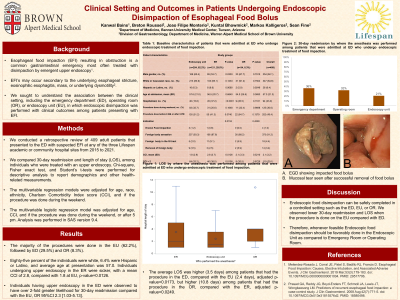Back


Poster Session B - Monday Morning
Category: General Endoscopy
B0284 - Clinical Setting and Outcomes in Patients Undergoing Endoscopic Disimpaction of Esophageal Food Bolus
Monday, October 24, 2022
10:00 AM – 12:00 PM ET
Location: Crown Ballroom

Has Audio

Kanwal Bains, MBBS
Brigham and Women’s Hospital
Boston, MA
Presenting Author(s)
Kanwal Bains, MBBS1, Breton Roussel, MD2, Joao Filipe Monteiro, PhD2, Kuntal Bhowmick, MD2, Markos Kalligeros, MD2, Sean Fine, MD, MS2
1Brigham and Women’s Hospital, Boston, MA; 2Brown University, Providence, RI
Introduction: Esophageal food impaction (EFI) resulting in obstruction is a common gastrointestinal emergency most often treated with disimpaction by emergent upper endoscopy. EFI’s may occur secondary to the underlying esophageal stricture, eosinophilic esophagitis, mass, or underlying dysmotility. We sought to understand the association between the clinical setting, including the emergency department (ED), operating room (OR), or endoscopy unit (EU), in which endoscopic disimpaction was performed with clinical outcomes among patients presenting with EFI.
Methods: We conducted a retrospective review of 409 adult patients that presented to the ED with suspected EFI at any of the three Lifespan academic or community hospital sites from 2015 to 2021. We compared 30-day readmission and length of stay (LOS), among individuals who were treated with an upper endoscopy. Chi-square, Fisher exact test, and Student’s t-tests were performed for descriptive analysis to report demographics and other health-related measurements. The multivariable regression models were adjusted for age, race, ethnicity, Charlson Comorbidity Index score (CCI), and if the procedure was done during the weekend. The multivariable logistic regression model was adjusted for age, CCI, and if the procedure was done during the weekend, or after 5 pm. Analysis was performed in SAS version 9.4.
Results: The majority of the procedures were done in the EU (62.2%), followed by ED (29.5%) and OR (8.3%). Eighty-five percent of the individuals were white, 6.4% were hispanic or latino, and average age at presentation was 57.0. Individuals undergoing upper endoscopy in the ER were sicker, with a mean CCI of 2.8, compared with 1.8 at EU, p-value=0.0126. The average LOS was higher (3.5 days) among patients that had the procedure in the ED, compared with the EU (2.4 days), adjusted p-value=0.0173, but higher (10.8 days) among patients that had the procedure in the OR, compared with the ER, adjusted p-value=0.0249. Individuals having upper endoscopy in the ED were observed having over 2-fold greater likelihood for 30-day readmission compared with the EU, OR 95%CI 2.3 [1.03-5.13].
Discussion: Endoscopic food disimpaction can be safely completed in a controlled setting such as the ED, EU, or OR. We observed a 30-day readmission and lower LOS is seen when the procedure is done on the EU compared with ED.
Disclosures:
Kanwal Bains, MBBS1, Breton Roussel, MD2, Joao Filipe Monteiro, PhD2, Kuntal Bhowmick, MD2, Markos Kalligeros, MD2, Sean Fine, MD, MS2. B0284 - Clinical Setting and Outcomes in Patients Undergoing Endoscopic Disimpaction of Esophageal Food Bolus, ACG 2022 Annual Scientific Meeting Abstracts. Charlotte, NC: American College of Gastroenterology.
1Brigham and Women’s Hospital, Boston, MA; 2Brown University, Providence, RI
Introduction: Esophageal food impaction (EFI) resulting in obstruction is a common gastrointestinal emergency most often treated with disimpaction by emergent upper endoscopy. EFI’s may occur secondary to the underlying esophageal stricture, eosinophilic esophagitis, mass, or underlying dysmotility. We sought to understand the association between the clinical setting, including the emergency department (ED), operating room (OR), or endoscopy unit (EU), in which endoscopic disimpaction was performed with clinical outcomes among patients presenting with EFI.
Methods: We conducted a retrospective review of 409 adult patients that presented to the ED with suspected EFI at any of the three Lifespan academic or community hospital sites from 2015 to 2021. We compared 30-day readmission and length of stay (LOS), among individuals who were treated with an upper endoscopy. Chi-square, Fisher exact test, and Student’s t-tests were performed for descriptive analysis to report demographics and other health-related measurements. The multivariable regression models were adjusted for age, race, ethnicity, Charlson Comorbidity Index score (CCI), and if the procedure was done during the weekend. The multivariable logistic regression model was adjusted for age, CCI, and if the procedure was done during the weekend, or after 5 pm. Analysis was performed in SAS version 9.4.
Results: The majority of the procedures were done in the EU (62.2%), followed by ED (29.5%) and OR (8.3%). Eighty-five percent of the individuals were white, 6.4% were hispanic or latino, and average age at presentation was 57.0. Individuals undergoing upper endoscopy in the ER were sicker, with a mean CCI of 2.8, compared with 1.8 at EU, p-value=0.0126. The average LOS was higher (3.5 days) among patients that had the procedure in the ED, compared with the EU (2.4 days), adjusted p-value=0.0173, but higher (10.8 days) among patients that had the procedure in the OR, compared with the ER, adjusted p-value=0.0249. Individuals having upper endoscopy in the ED were observed having over 2-fold greater likelihood for 30-day readmission compared with the EU, OR 95%CI 2.3 [1.03-5.13].
Discussion: Endoscopic food disimpaction can be safely completed in a controlled setting such as the ED, EU, or OR. We observed a 30-day readmission and lower LOS is seen when the procedure is done on the EU compared with ED.
Disclosures:
Kanwal Bains indicated no relevant financial relationships.
Breton Roussel indicated no relevant financial relationships.
Joao Filipe Monteiro indicated no relevant financial relationships.
Kuntal Bhowmick indicated no relevant financial relationships.
Markos Kalligeros indicated no relevant financial relationships.
Sean Fine: Bristol Meyers Squibb – Consultant.
Kanwal Bains, MBBS1, Breton Roussel, MD2, Joao Filipe Monteiro, PhD2, Kuntal Bhowmick, MD2, Markos Kalligeros, MD2, Sean Fine, MD, MS2. B0284 - Clinical Setting and Outcomes in Patients Undergoing Endoscopic Disimpaction of Esophageal Food Bolus, ACG 2022 Annual Scientific Meeting Abstracts. Charlotte, NC: American College of Gastroenterology.
